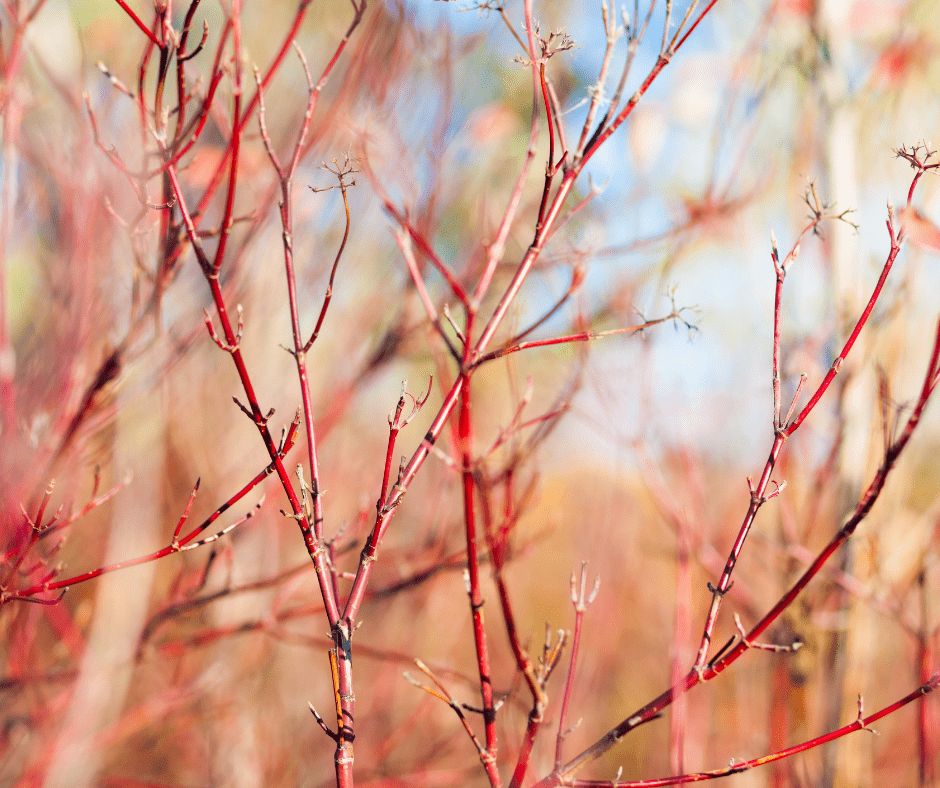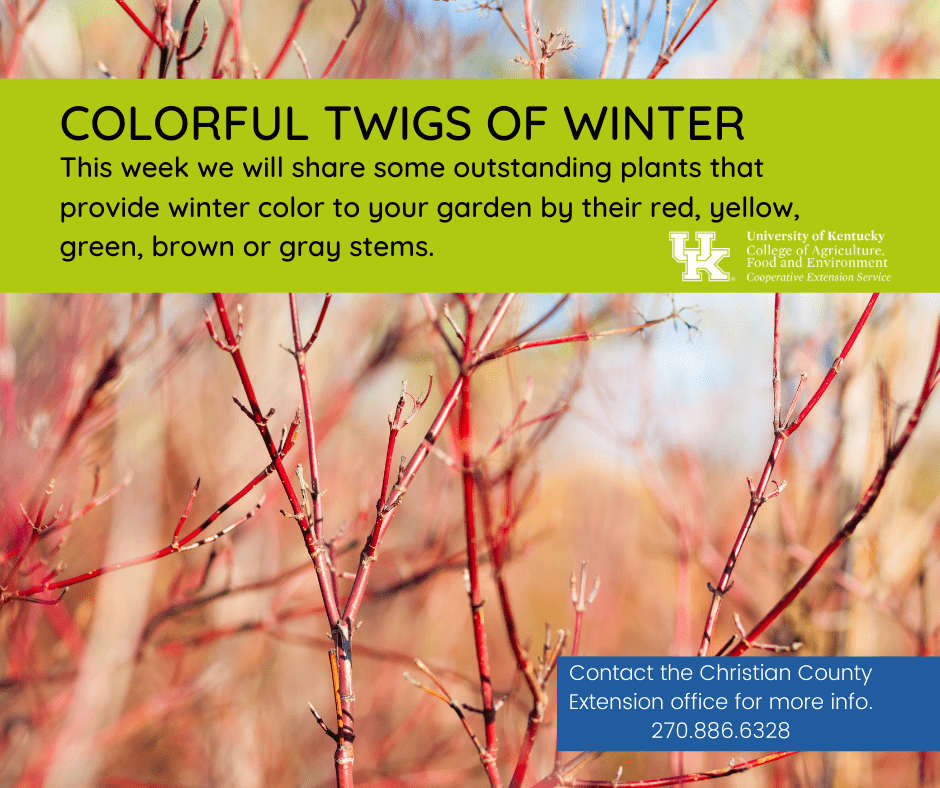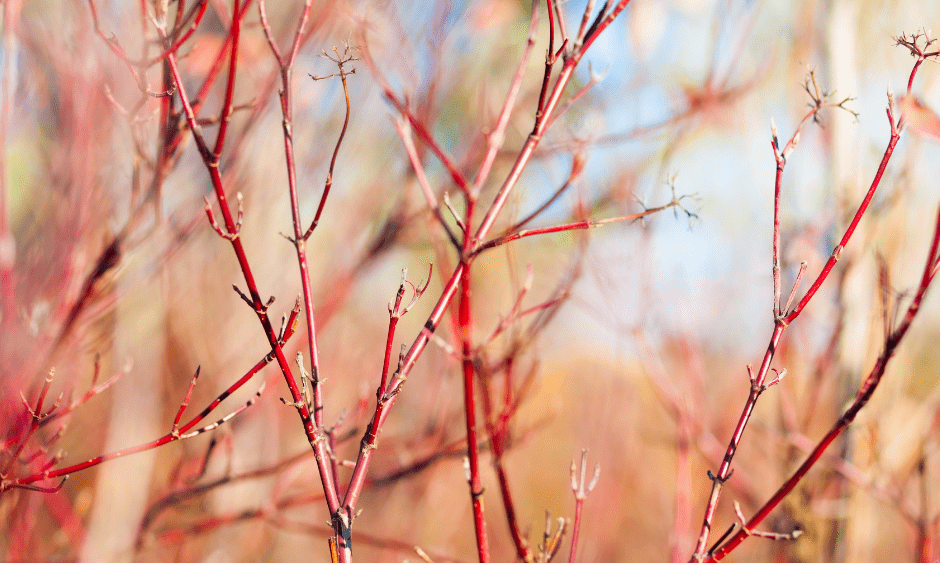
Dr. Donald Wyman was the horticulturist of Arnold Arboretum of Harvard University for thirty-five years (1935-1970). He is best known for introducing new plants to American gardens. In one, two-year span he located seeds or plants of 586 species and varieties not then found at the Arboretum. During a trip to Europe in 1965, he returned with 930 species and varieties, including many first-time introductions to the United States.
In a 1947 document called Woody Plants with Interesting Bark in Winter, Dr. Wyman listed nearly 150 trees and shrubs with red, yellow, green, gray, or brown twigs that give a little something extra to the landscape during an otherwise less than colorful season. The following is a shortlist of popular and some possibly not so well-known shrubs that will fit well in the typical urban landscape and survive our growing conditions.

The Reds:
Think red and Red Twig Dogwood should be at the top of the list. Several Cornus species could be called “red-twig”. One recent release from Proven Winners is called Cornus stolonifera ‘Arctic Fire’. This wonderful shrub has intense, vibrant dark red stems, and doesn’t sucker like other red-twig species might. ‘Arctic Fire’ stays just 3 to 4 feet tall, so it works in many urban landscape situations. Dwarf Cranberry Bush (Viburnum opulus ‘Nanum’) is a great choice for a low-growing dense mounding shrub for a handsome hedge or filler plant. ‘Nanum’ stays 2 to 2 ½ feet tall, is deer resistant, and has red fall color. New twigs also give a splash of red to the winter. Sweetbells Leucothoe (Leucothoe racemosa) is an underused native shrub whose current year’s stems are a mix of red and green. Leucothoe is a 4 to 6 feet tall spreading, twiggy evergreen that needs part shade and a moist to wet site. Rows of white bell-shaped flowers appear in early summer.
The Yellows:
Almost as popular as red twigs are the yellow twig dogwoods. Among these Cornus sericea ‘Budd’s Yellow’ tops the list as a favorite. ‘Bud’s Yellow’ is a rapidly growing, multi-trunked shrub to 8 feet tall. Its’ bright yellow stems are particularly showy against a snowy backdrop. Kerria japonica ‘Kin Kan’ is similar to other Kerrias – 3 to 6 feet tall, yellow fall color, and showy yellow flowers in May. It differs in that its twigs are yellow or yellow with green stripes making it stand out in winter. Dusty Zenobia (Zenobia pulverulenta) is another one of those infrequently used natives offering one more season of interest than the average shrub. Dusty Zenobia has an open habit with arching branches growing to 6 feet and features small bell-shaped flowers with pale turquoise stems in spring. Leaves turn yellow-orange in fall and, of course, young twigs are a light yellowish color.
The Greens:
Scotch Broom (Cytisus scoparius) is a 5-foot deciduous shrub that gives year-round green stem color to the landscape. Broom can be used as an accent for its stunning bloom of pea-like yellow flowers in May and June. Blooming is profuse and very showy. Unfortunately, Scotch Broom tends to be a short-lived plant for us in Kentucky. Not as fragrant as tropical jasmine, Winter Jasmine (Jasminum nudiflorum) is hardy and more tolerant to site and weather conditions. This rapid grower is more like a groundcover as it sprawls across beds with arching green stems. Flowers are light yellow and appear in winter and very early spring.
The Browns:
Lemoine mockorange (Philadelphus x lemoinei) is a rapidly growing shrub up to 8 feet tall with arching branches. Mockorange twigs give a conspicuous light brown color to the winter landscape. Slender Deutzia (Deutzia gracilis) is a small ornamental shrub with showy white flowers in early May. Twigs are tan to gray and exfoliating. Hydrangea arborescens, Smooth Hydrangea, have large showy flowers popular with hydrangea lovers. But beauty can also be found in its shredding, orange-brown stems during winter. Another attractive exfoliating bark can be found on Beautybush (Kolkwitzia amabilis) a large deciduous shrub with bell-shaped flowers in May. Beautybush is rising in popularity because of its adaptability to almost any site and pest resistance.
The Grays:
You might not think of gray twigs as showy in winter, but the ones below are sufficiently prominent to add a colorful contrast in the winter. Chinese neillia (Neillia sinensis) has a rounded form and delicate whitish-pink tubular flowers. It prefers partial shade and moist but well-drained sites. All twigs on Neillia are a showy gray. Fiveleaf Aralia (Acanthopanax sieboldianus) is an erect, upright shrub with arching branches that tend to flop over. It makes a great screen or barrier and is tolerant of practically any site. Bottlebrush Buckeye (Aesculus parviflora) is a native shrub, large and spreading, with long panicles of white blooms in mid-July. Its twigs are smooth, gray, and showy.
A few tips from Dr. Wyman’s article will help you get the most colorful twigs from these shrubs. Pruning out older stems or even pruning the shrub to the ground in the spring will often yield brightly colored stems by next winter. This technique works with any multi-stemmed, suckering shrub. Placing shrubs in direct sunlight can also help to intensify stem color, as will providing plants with adequate nitrogen fertilizer during the growing season. Sometimes, specific cultivars will be more consistent in stem color than the straight species. When purchasing plants, be sure to have the scientific name to verify you are getting the right plant.
— Kelly Jackson, Christian County Extension Agent






